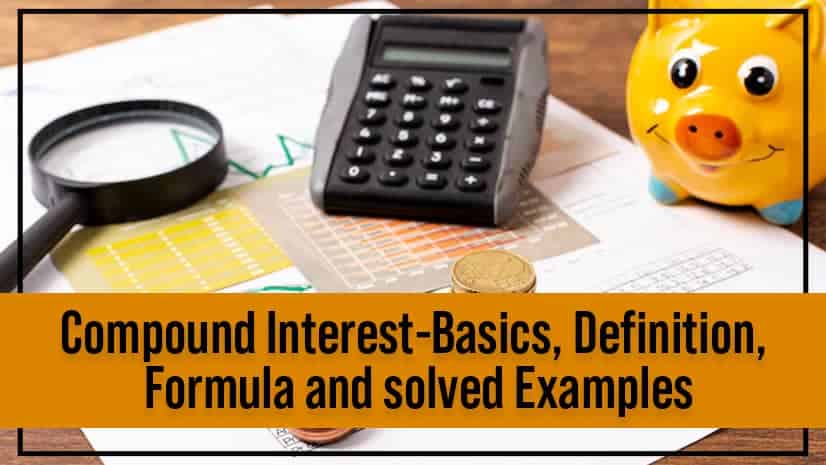The concept of compound interest is used in many sectors such as banking, finance, personal loans and so on. In compound interest , the interest is not added to the principal amount when calculating the interest for next year.
For eg:- when you make a payment for a home loan, firstly it goes to the monthly interest and the amount you loaned is still the same.
In this blog, we will learn the definition, compound interest formula, and how we can calculate the compound interest with a few examples.
What we should know About Compound Interest?
Compound Interest is also known as S.I is the method of calculating the interest amount for principal amount of money and previous interest. In this, method interest applies to the original principal amount and the compounded interest at regular intervals.
We can understand the concept of compound interest by this simple relation:-
Compound Interest = Interest on Principal + Compounded Interest at Regular Intervals
The compound interest is always calculated at regular intervals. The intervals can be annually(yearly), semi-annually(half-yearly i.e 6 months), quarterly(3 months), monthly, etc. Banks and other financial organizations calculate the total amount based on compound interest only.
Before going on the Compound interest formula, let us understand some basic terms that are used when we are calculating interest.
Read More : Multiplication of Fractions
Principal Amount
The principal amount is the amount that was initially borrowed from the bank or invested(deposited) in the bank.The principal is represented by P.
Rate
Rate can be defined as the rate of interest at which the principal amount is given to the borrower or investor for a certain period of time. The rate of interest can be 3%, 12%, or 15%, etc. The rate of interest is represented by R.
Time
Time is the duration or time period for which the principal amount is given to a borrower or investor. Time is symbolized by T.
Read More : Fractions From Basics. Understand What is Fraction, Types with Examples
Frequency
Frequency is the number of times the compound interest is calculated annually. Frequency is symbolized by n.
Amount
Let us understand this term with an example:-
When someone takes a loan from a bank or somewhere else, he/she has to return the principal amount borrowed plus the interest amount, and this total return is called the Amount.
Read More : Basic Concept Of Angles In Geometry
Compound Interest Formula
We can calculate compound interest using the given formula if the principal amount, rate of interest, frequency, and time periods are given.
The compound interest formula is specified as:
Compound interest = C.I = P(1+r/n)nt – P
Where C.I is compound interest
P = Principal amount
R = Rate of interest (in percentage)
T = time duration (in years)
N = frequency
If we want to calculate the total amount, we can calculate it using the given formula: –
Compound Interest = Interest on Principal + Compounded Interest at Regular Intervals
Read More : Find your LCM in 10 seconds
Compound Interest Solved Examples:
Example 1:
Neha borrows Rs4000 at an interest rate of 10% per annum, compounded half-yearly for a period of 2 years. What will be the amount she has to pay after a period of 2 years?
Solution:
In this example, the principal amount = P = Rs 4000
Rate of interest per year = R = 10%
Time for which it is borrowed = T = 2 year
Frequency = 2 (half-yearly)
Thus,
Amount = P(1+{r / n}/100)nt
= P(1+{r / 2}/100)2n
= 4000(1+{10 / 2}/100)2(2)
= 4862.03
Hence, the final amount is Rs. 4862.03.
Read More : QUADRATIC EQUATIONS
Example 2:
Shobha’s father had borrowed Rs 6,000 from the bank and the rate of interest was 10% per annum half yearly for a period of 2 years. What would be the amount to be paid after 1 year?
Solution:
In this example, the principal amount = P = Rs 6000
Rate of interest per year = R = 10%
Time for which it is borrowed = T = 2 year
Frequency = 2 (half-yearly)
Thus,
Amount = P(1+{r / n}/100)nt
= P(1+{r / 2}/100)2(2)
= 6000(1+{10 / 1}/100)4
= 6862.03
Hence, the final amount is Rs. 6862.03.
Read More : Sum of cubes of n natural numbers
Practice Questions for You:-
- Kavya has taken a loan of Rs 100,000 for 3 years at the rate of 3.5% per annum compounded monthly for a time period of 3 years. Find the compound interest she has to pay at the end of 3 years.
- Raghav purchased a plot worth Rs480,0000, he has taken a loan from the bank at 10% per annum compounded, half yearly for a period of 4 years. How much does he have to pay after the period?
- Kritika pays Rs 12000 as an amount on the sum(principal amount)of Rs 5000 compounded annually that she had borrowed for 3 years. Find the rate of interest.
In this blog, we have learned what compound interest is, the formula to calculate compound interest, and solved examples of compound interest.





